Carbon Sequestration by Reforesting Legacy Grasslands on Coal Mining Sites
Abstract
1. Introduction
2. Methods
2.1. Soil Carbon Measurements on Reforestation Sites
2.2. Soil Carbon Modeling on ARRI Reforestation Sites
2.3. Soil and Non-Soil Carbon Estimates from Previous Publications
2.3.1. Non-Soil Carbon on Reforestation Sites from Previous Publications
2.3.2. Soil and Non-Soil Carbon on Grassland Reclamation Sites from Previous Publications
2.3.3. Soil Non-Soil Carbon on Non-Mined Sites
2.4. Reclamation Scenarios for Regional Analysis
3. Results
3.1. Soil Carbon
3.2. Plant Carbon and Total Forest Carbon
3.3. Projection of Scenarios
4. Discussion
Author Contributions
Funding
Acknowledgments
Conflicts of Interest
References
- Acton, P.M.; Fox, J.F.; Campbell, J.E.; Jones, A.L.; Rowe, H.; Martin, D.; Bryson, S. Role of soil health in maintaining environmental sustainability of surface coal mining. Environ. Sci. Technol. 2011, 45, 10265–10272. [Google Scholar] [CrossRef] [PubMed]
- Wickham, J.; Wood, P.B.; Nicholson, M.C.; Jenkins, W.; Druckenbrod, D.; Suter, G.W.; Strager, M.P.; Mazzarella, C.; Galloway, W.; Amos, J. The overlooked terrestrial impacts of mountaintop mining. BioScience 2013, 63, 335–348. [Google Scholar] [CrossRef]
- IEA. Coal 2019; IEA: Paris, France, 2019; Available online: https://www.iea.org/reports/coal-2019 (accessed on 10 October 2020).
- IEA. Coal Information: Overview; IEA: Paris, France, 2020; Available online: https://www.iea.org/reports/coal-information-overview (accessed on 10 October 2020).
- Díaz, S.; Hector, A.; Wardle, D.A. Biodiversity in forest carbon sequestration initiatives: Not just a side benefit. Curr. Opin. Environ. Sustain. 2009, 1, 55–60. [Google Scholar] [CrossRef]
- Wickham, J.D.; Riitters, K.H.; Wade, T.G.; Coan, M.; Homer, C. The effect of Appalachian mountaintop mining on interior forest. Landsc. Ecol. 2007, 22, 179–187. [Google Scholar] [CrossRef]
- United States Congress. The Surface Mining Control and Reclamation Act (SMCRA) of 1977; U.S. Public Law 1977; United States Congress: Washington, DC, USA, 1977; pp. 95–187.
- Fox, J.F.; Acton, P.; Campbell, J.E. Carbon and Mountaintop Mining. BioScience 2014. [Google Scholar] [CrossRef][Green Version]
- Pericak, A.A.; Thomas, C.J.; Kroodsma, D.A.; Wasson, M.F.; Ross, M.R.; Clinton, N.E.; Campagna, D.J.; Franklin, Y.; Bernhardt, E.S.; Amos, J.F. Mapping the yearly extent of surface coal mining in Central Appalachia using Landsat and Google Earth Engine. PLoS ONE 2018, 13, e0197758. [Google Scholar] [CrossRef]
- Angel, P.; Davis, V.; Burger, J.; Graves, D.; Zipper, C. The Appalachian Regional Reforestation Initiative. In The Forestry Reclamation Approach: Guide to Successful Reforestation of Mined Lands; US Department of Agriculture, Forest Service, Northern Research Station: Newtown Square, PA, USA, 2017. [Google Scholar]
- ARRI. Appalachian Regional Reforestation Initiative. 2020. Available online: https://arri.osmre.gov (accessed on 8 September 2020).
- Popkin, G. The Green Miles. In The Washington Post Magazine; Fred Ryan: Washington, DC, USA, 2020. [Google Scholar]
- Amichev, B.Y.; Burger, J.A.; Rodrigue, J.A. Carbon sequestration by forests and soils on mined land in the Midwestern and Appalachian coalfields of the US. For. Ecol. Manag. 2008, 256, 1949–1959. [Google Scholar] [CrossRef]
- Angel, P.N. Forest Establishment and Water Quality Characteristics as Influenced by Spoil Type on a Loose Graded Surface Mine in Eastern Kentucky. Ph.D. Thesis, University of Kentucky, Lexington, KY, USA, 2008. [Google Scholar]
- Angel, P.N. The Forestry Reclamation Approach and the Measure of Its Success in Appalachia. In Proceedings of the 2009 National Meeting of the American Society of Mining and Reclamation, Billings, MT, USA, 30 May–5 June 2009; Barnhisel, R.I., Ed.; ASMR: Lexington, KY, USA, 2009. [Google Scholar]
- Angel, P.N. Surface Mine Restoration Research: Evaluation of Tree Response to Low Compaction Reclamation Techniques. In Proceedings of the 7th International Conference on Acid Rock Drainage (ICARD), St. Louis, MO, USA, 26–30 March 2006; Barnhisel, R.I., Ed.; American Society of Mining and Reclamation (ASMR): Champaign, IL, USA, 2006. [Google Scholar]
- Acton, P.M. Study of Terrestrial Carbon in Forests and Mined Lands in the Southern Appalachian Forest Region. Master’s Thesis, University of Kentucky, Lexington, KY, USA, 2012. [Google Scholar]
- Knops, J.; Tilman, D. Dynamics of soil nitrogen and carbon accumulation for 61 years after agricultural abandonment. Ecology 2000, 81, 88–98. [Google Scholar] [CrossRef]
- United States Department of Agriculture. Natural Resource Conservation Service, Soil Survey Division, World Soil Resources, Soil Organic Carbon Map; Natural Resources Conservation Service. Available online: https://www.nrcs.usda.gov/wps/portal/nrcs/detail/soils/use/?cid=nrcs142p2_054018 (accessed on 2 February 2017).
- Campbell, J.E.; Fox, J.F.; Acton, P.M. Terrestrial carbon losses from mountaintop coal mining offset regional forest carbon sequestration in the 21st century. Environ. Res. Lett. 2012, 7, 045701. [Google Scholar] [CrossRef]
- Parton, W.; Schimel, D.; Cole, C.; Ojima, D. Analysis of factors controlling soil organic matter levels in Great Plains grasslands. Soil Sci. Soc. Am. 1987, 51, 1173–1179. [Google Scholar] [CrossRef]
- Sanford, R., Jr.; Parton, W.; Ojima, D.; Lodge, D. Hurricane effects on soil organic matter dynamics and forest production in the Luqillo experimental forest, Puerto Rico: Results of simulation modeling. Biotropica 1991, 23, 364–372. [Google Scholar] [CrossRef]
- Metherell, A.K.; Harding, L.A.; Cole, C.V.; Parton, W.J. CENTURY: Soil Organic Matter Model Environment; Technical Documentation, Agroecosystem Version 4.0, GPSR Technical Report 4; USDA Agricultural Research Service: Fort Collins, CO, USA, 1993.
- Raich, J.; Parton, W.; Russell, A.; Sanford, R., Jr.; Vitousek, P. Analysis of factors regulating ecosystem development on Mauna Loa using the Century model. Biogeochemistry 2000, 51, 161–191. [Google Scholar] [CrossRef]
- Gupta, S.C.; Larson, W.E. Estimating soil water retention characteristics from particle size distribution, organic matter content and bulk density. Water Resour. Res. 1979, 15, 1633–1635. [Google Scholar] [CrossRef]
- Williamson, J.; Johnson, D. Mineralisation of organic matter in topsoils subjected to stockpiling and restoration at opencast coal sites. Plant Soil 1990, 128, 241–247. [Google Scholar] [CrossRef]
- Pan, Y.; Chen, J.M.; Birdsey, R.; McCullough, K.; He, L.; Deng, F. Age structure and disturbance legacy of North American forests. Biogeosciences 2011, 8, 715–732. [Google Scholar] [CrossRef]
- Liu, J.; Liu, S.; Loveland, T.R. Temporal evolution of carbon budgets of the Appalachian forests in the U.S. from 1972 to 2000. For. Ecol. Manag. 2006, 222, 191–201. [Google Scholar] [CrossRef]
- EPA. The Effects of Mountaintop Mines and Valley Fills on Aquatic Ecosystems of the Central Appalachian Coalfields; US Environmental Protection Agency: Washington, WA, USA, 2011.
- Lal, R. Soil carbon sequestration impacts on global climate change and food security. Science 2004, 304, 1623–1627. [Google Scholar] [CrossRef]
- Chatterjee, A.; Lal, R.; Shrestha, R.K.; Ussiri, D.A.N. Soil carbon pools of reclaimed minesoils under grass and forest landuses. Land Degrad. Dev. 2009, 20, 300–307. [Google Scholar] [CrossRef]
- Akala, V.A.; Lal, R. Soil organic carbon pools and sequestration rates in reclaimed minesoils in Ohio. J. Environ. Qual. 2001, 30, 2090–2104. [Google Scholar] [CrossRef]
- Friedlingstein, P.; Cox, P.; Betts, R.; Bopp, L.; von Bloh, W.; Brovkin, V.; Cadule, P.; Doney, S.; Eby, M.; Fung, I.; et al. Climate-carbon cycle feedback analysis: Results from the C4MIP model intercomparison. J. Clim. 2006, 19, 3337–3353. [Google Scholar] [CrossRef]
- Palmer, M.A.; Bernhardt, E.S.; Schlesinger, W.H.; Eshleman, K.N.; Foufoula-Georgiou, E.; Hendryx, M.S.; Lemly, A.D.; Likens, G.E.; Loucks, O.L.; Power, M.E.; et al. Mountaintop mining consequences. Science 2010, 327, 148–149. [Google Scholar] [CrossRef] [PubMed]
- Zipper, C.E.; Burger, J.A.; Skousen, J.G.; Angel, P.N.; Barton, C.D.; Davis, V.; Franklin, J.A. Restoring forests and associated ecosystem services on Appalachian coal surface mines. Environ. Manag. 2011, 47, 751–765. [Google Scholar] [CrossRef] [PubMed]
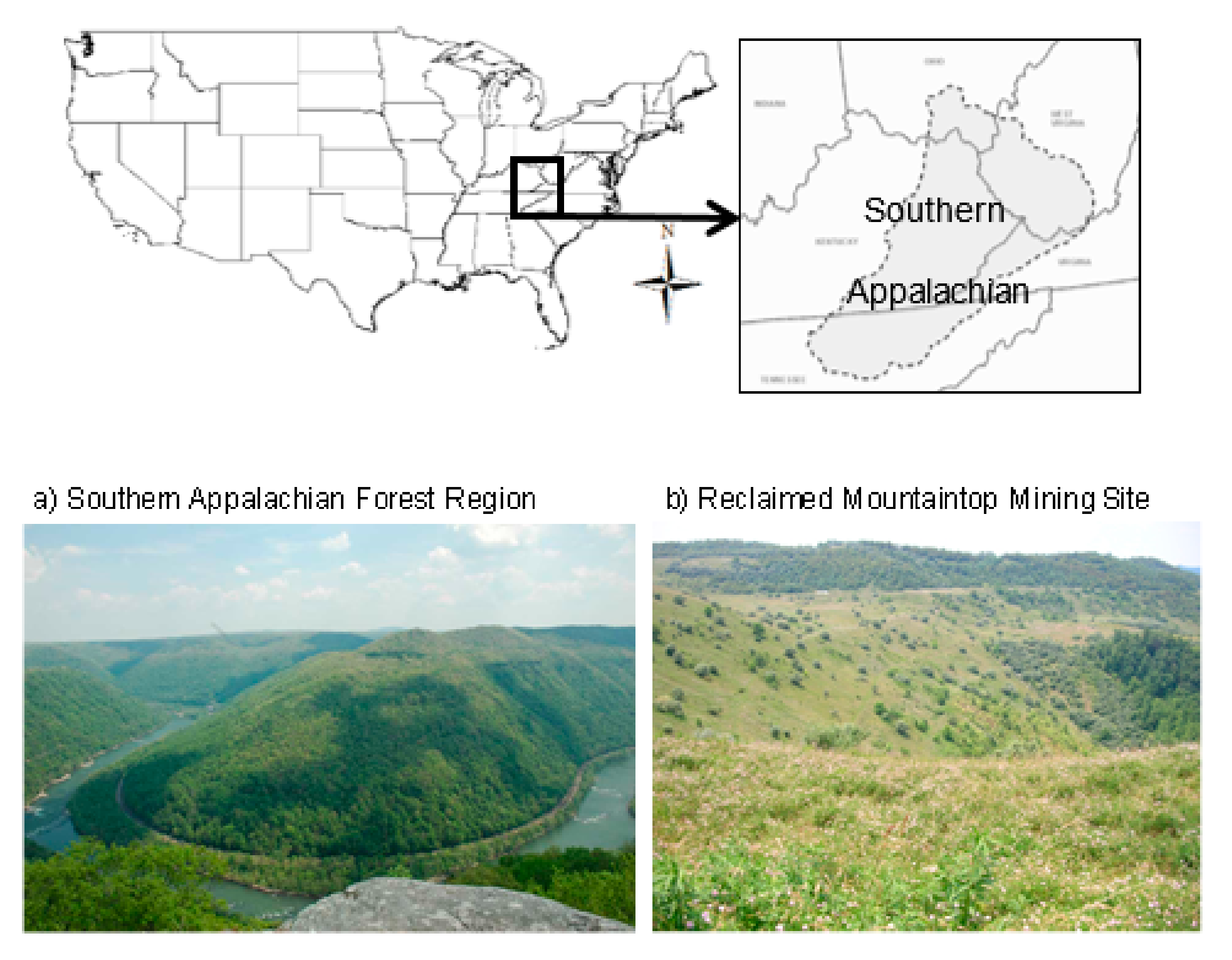


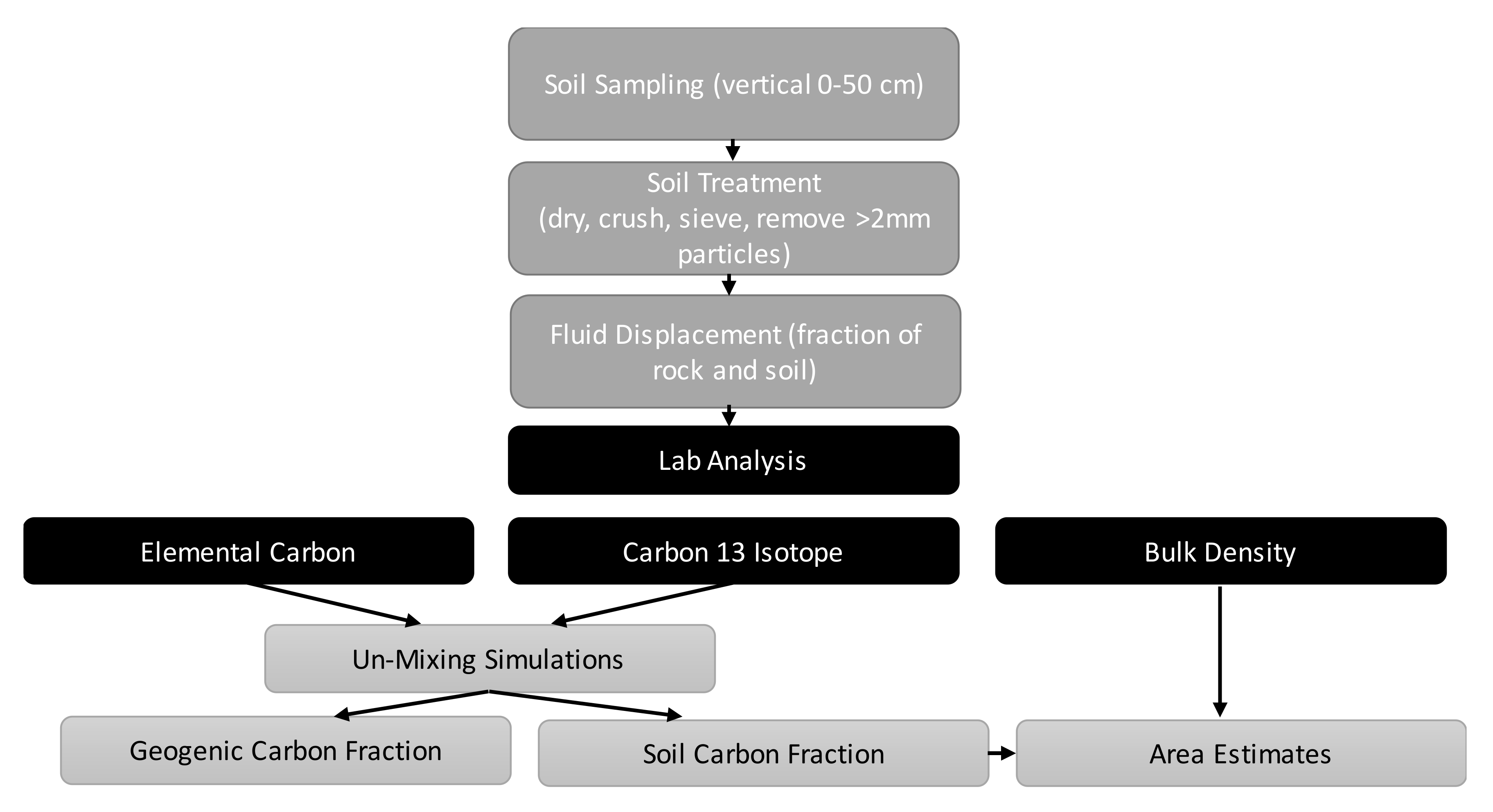
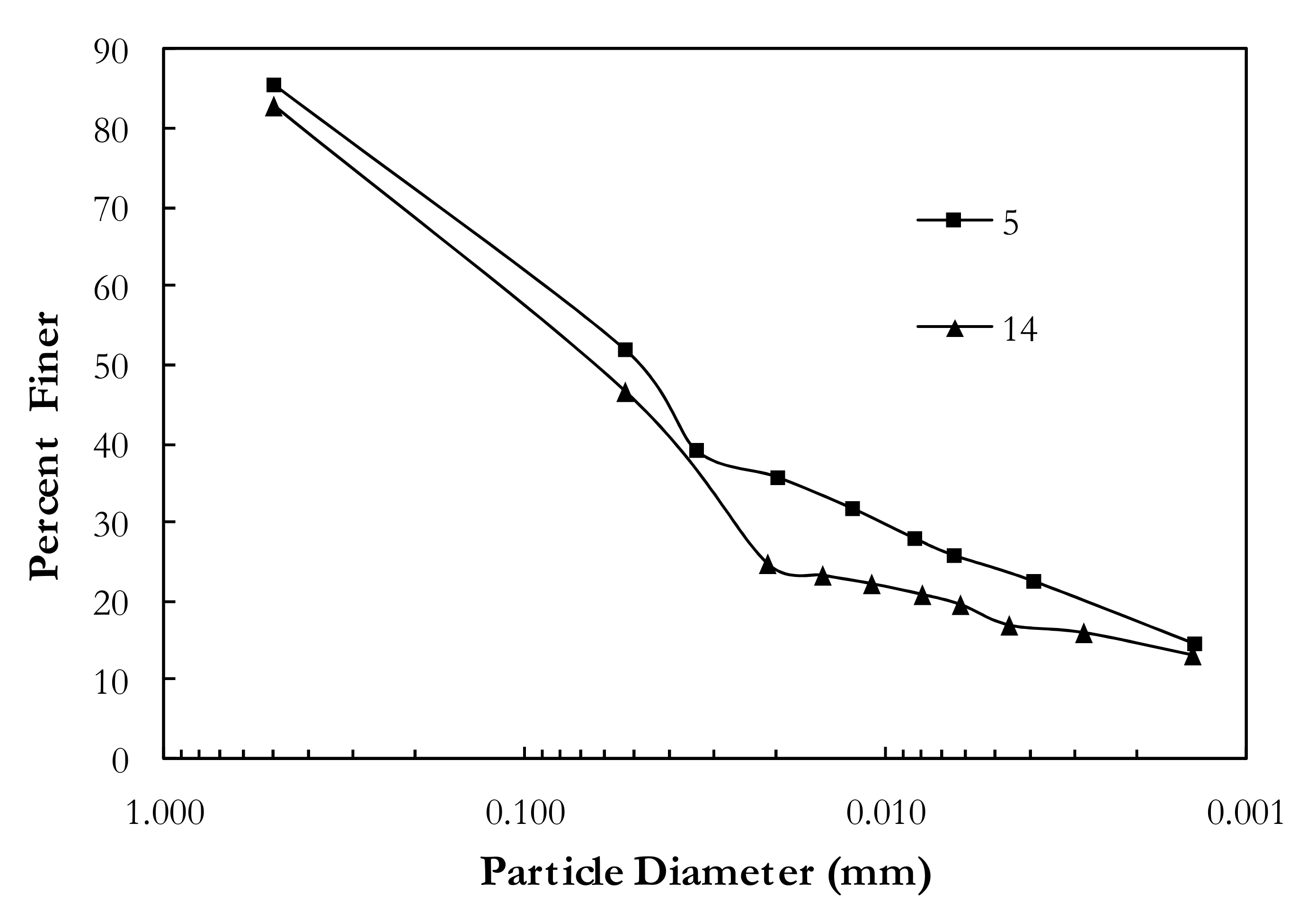
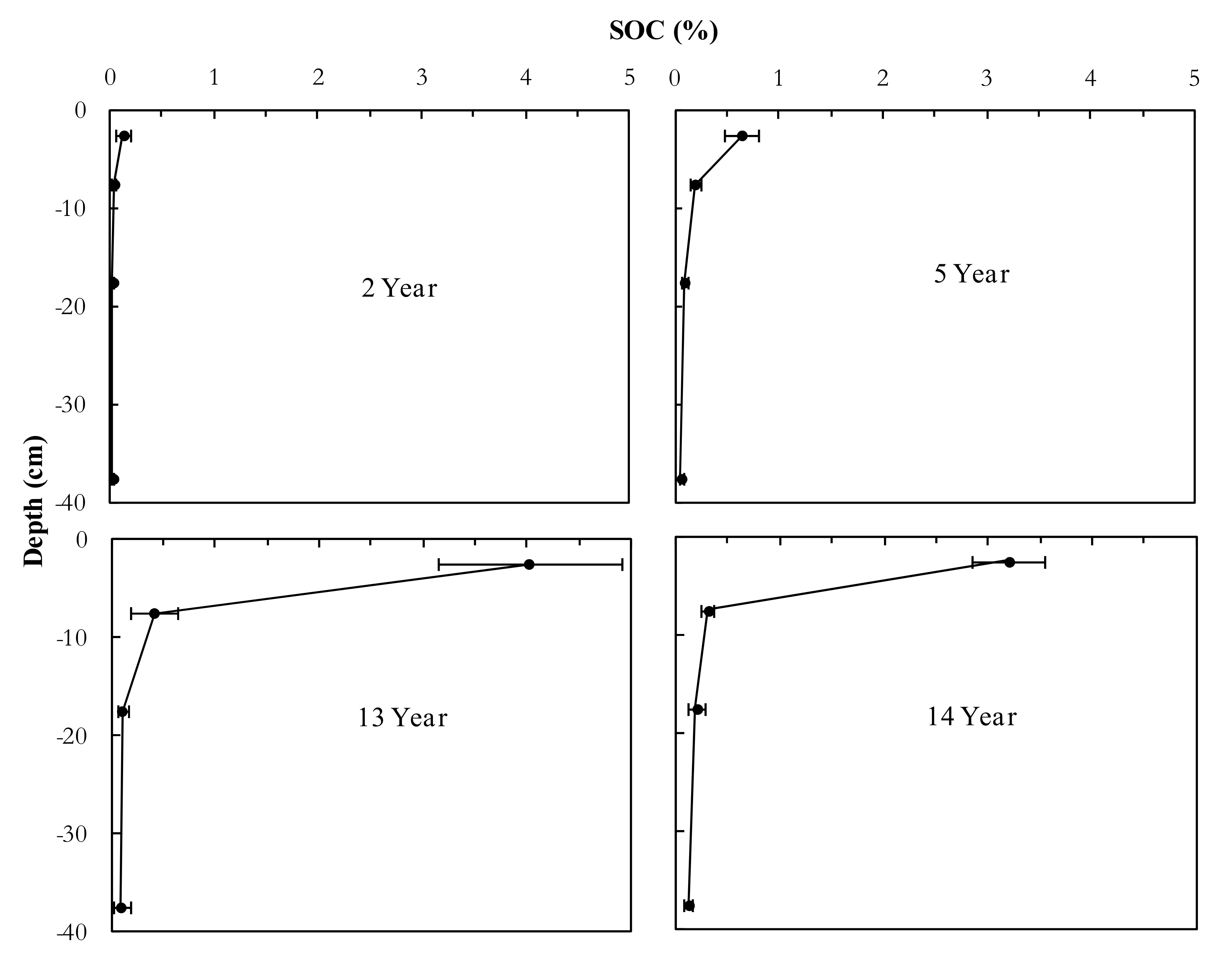
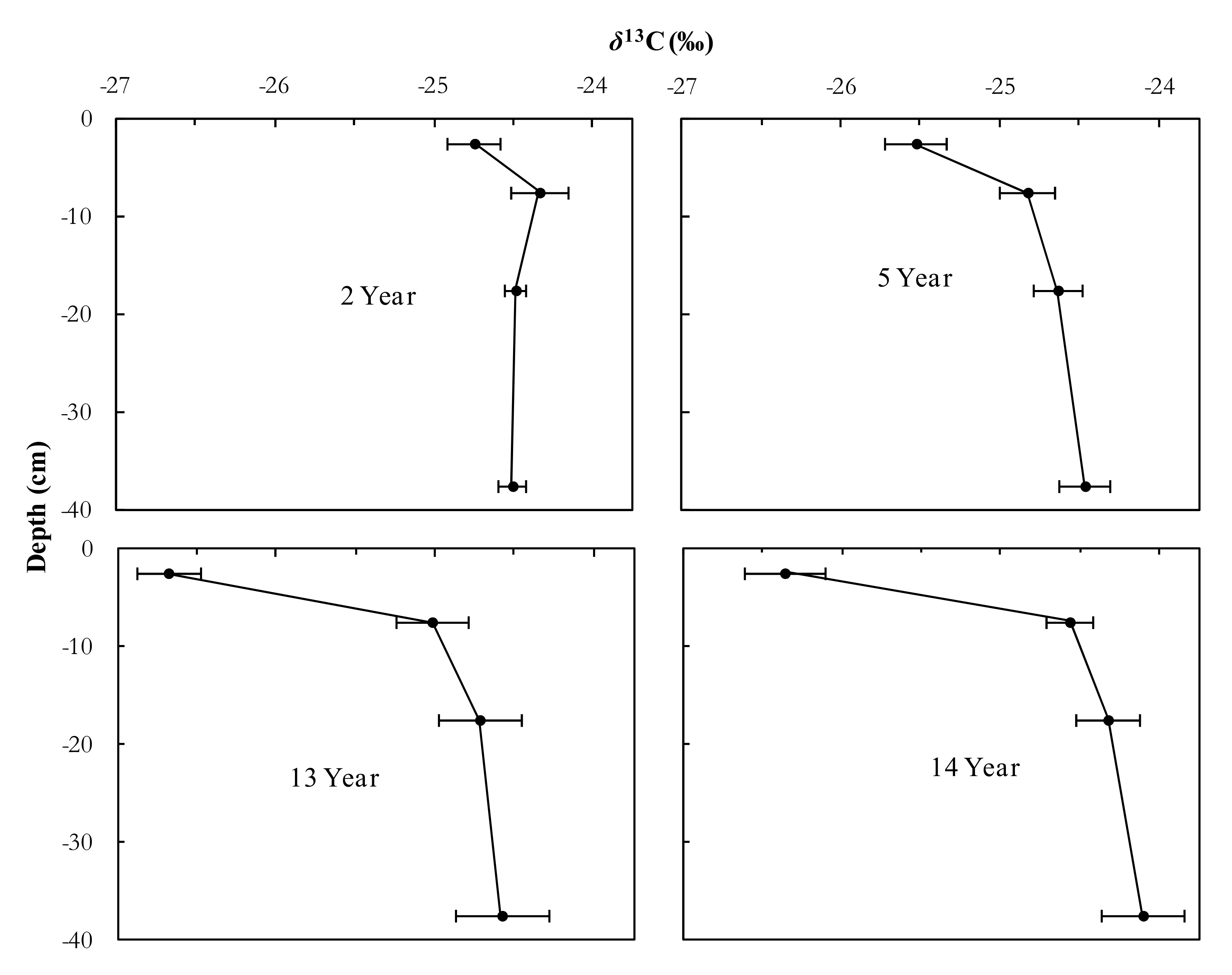
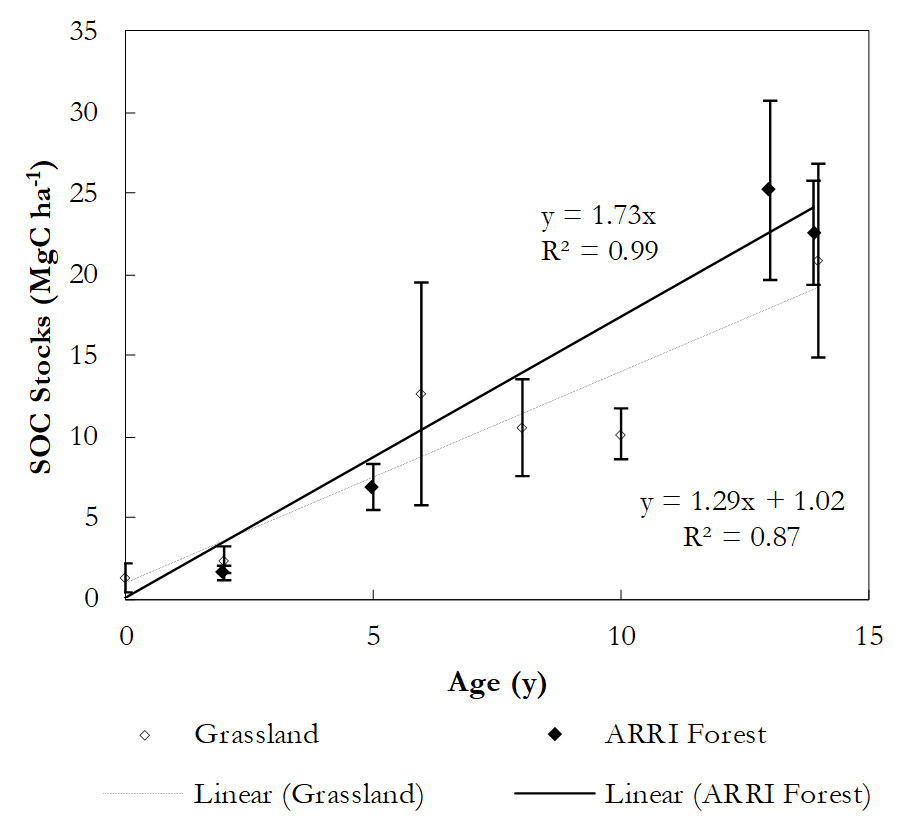
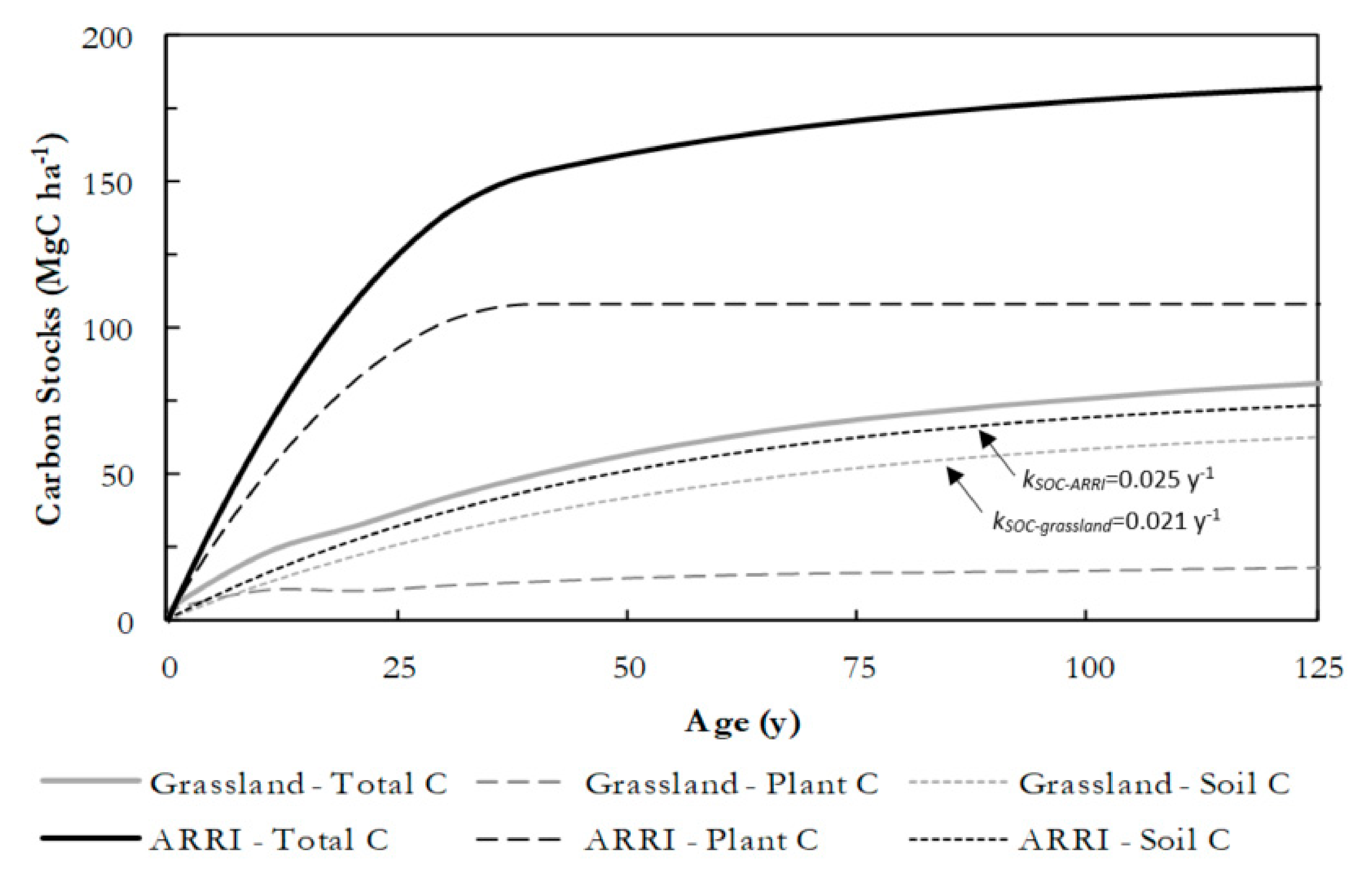
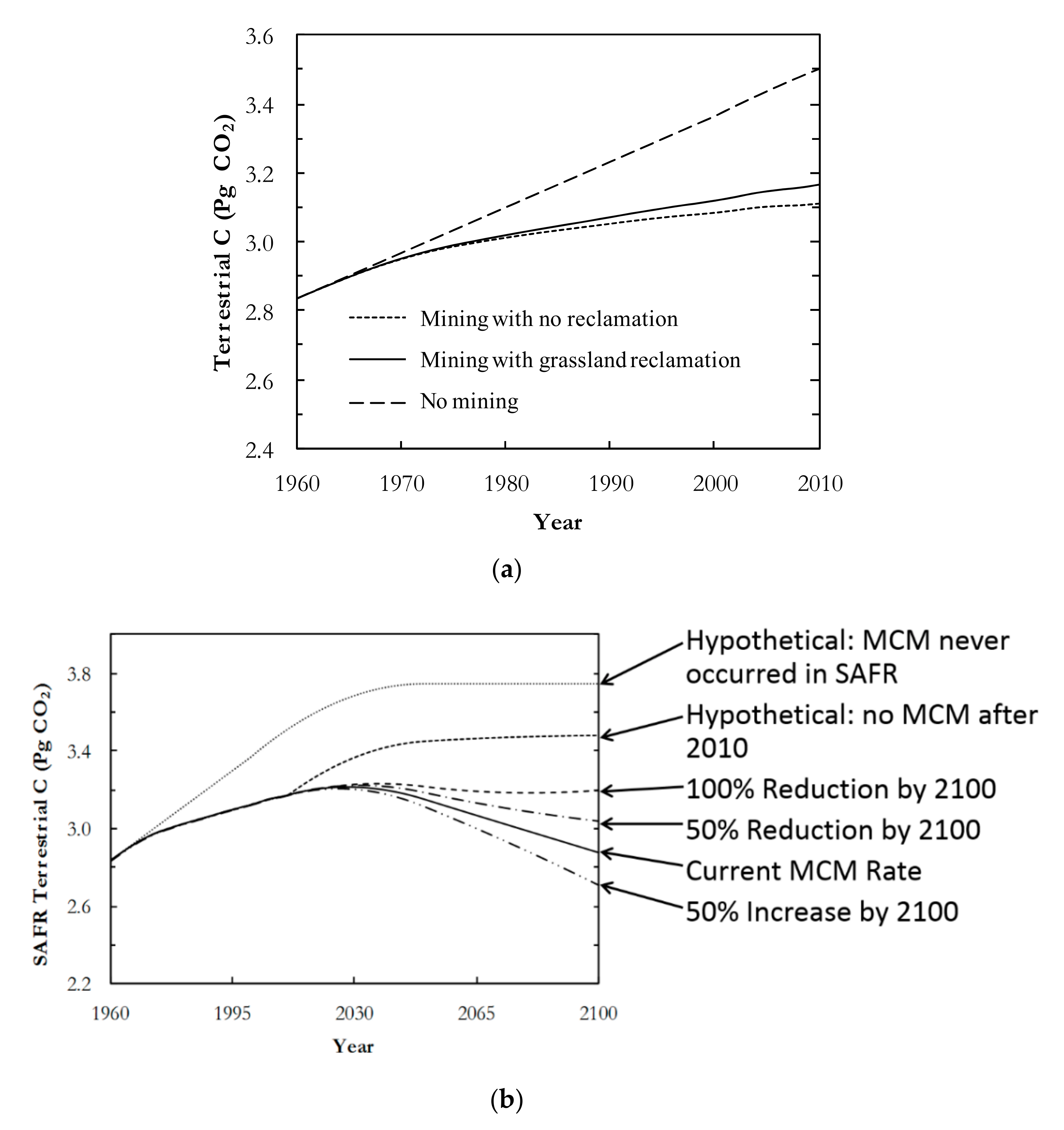
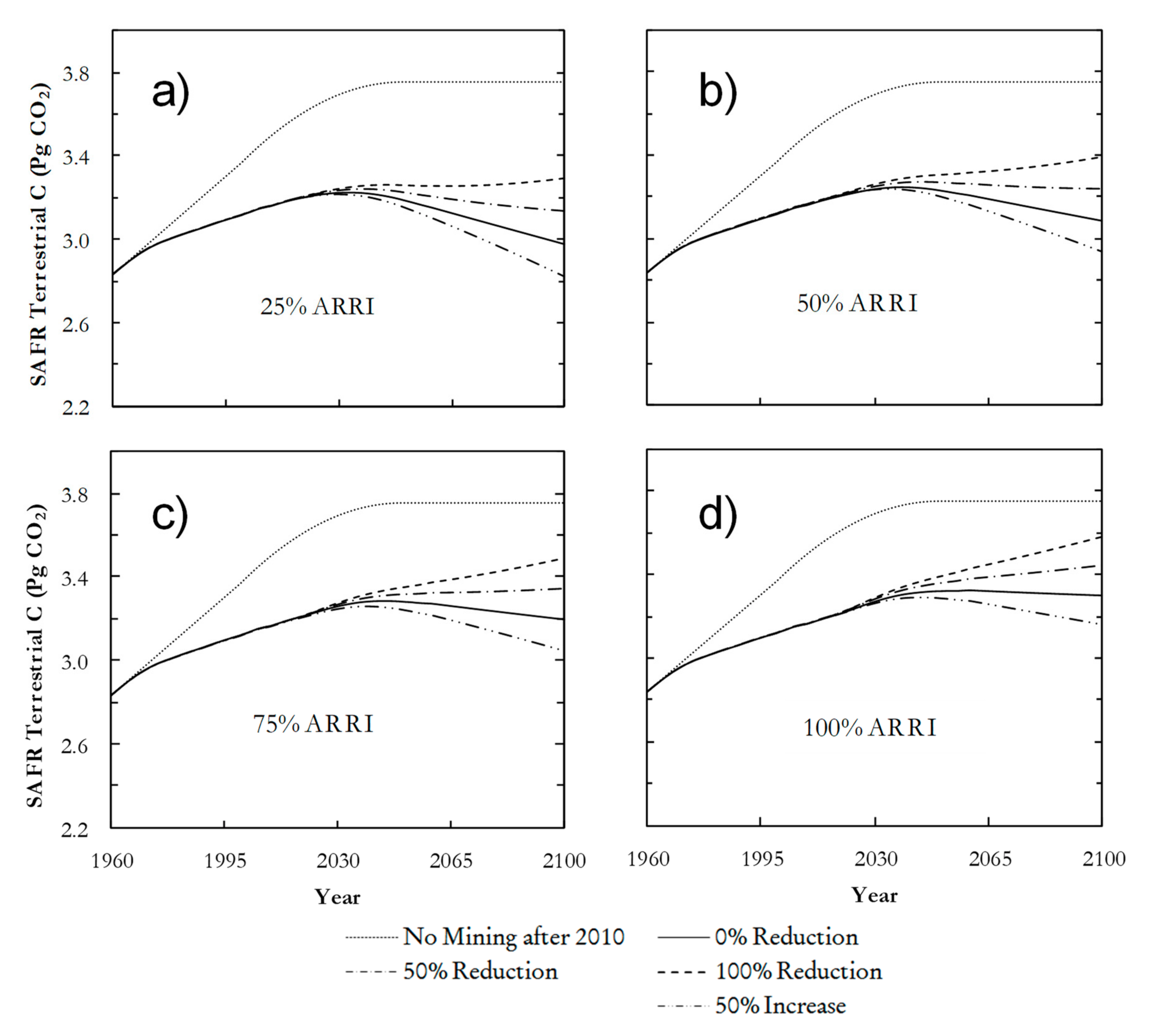
| Age (yr) | Interval (cm) | TOCavg (gC/100 g Soil) | δ13CTOC (‰) | δ13CGOC (‰) | δ13CSOC (‰) | SOCavg (gC/100 g Soil) | GOCavg (gC/100 g Soil) |
|---|---|---|---|---|---|---|---|
| 2 | 0 to 5 | 0.86 (0.07) | −24.75 (0.17) | −24.52 (0.09) | −27.50 (0.32) | 0.12 (0.07) | 0.74 (0.06) |
| 5 to 10 | 0.82 (0.05) | −24.34 (0.18) | 0.03 (0.02) | 0.78 (0.08) | |||
| 10 to 25 | 0.71 (0.03) | −24.49 (0.07) | 0.02 (0.01) | 0.69 (0.05) | |||
| 25 to 50 | 0.66 (0.05) | −24.51 (0.09) | 0.02 (0.01) | 0.63 (0.04) | |||
| 5 | 0 to 5 | 1.51 (0.19) | −25.53 (0.19) | −24.47 (0.16) | −27.50 (0.32) | 0.64 (0.17) | 0.87 (0.12) |
| 5 to 10 | 1.18 (0.14) | −24.83 (0.17) | 0.19 (0.05) | 1.00 (0.14) | |||
| 10 to 25 | 0.95 (0.14) | −24.64 (0.15) | 0.09 (0.03) | 0.86 (0.09) | |||
| 25 to 50 | 1.02 (0.13) | −24.47 (0.16) | 0.06 (0.02) | 0.96 (0.08) | |||
| 13 | 0 to 5 | 5.25 (0.77) | −26.68 (0.20) | −24.58 (0.29) | −27.50 (0.32) | 4.02 (0.88) | 1.23 (0.22) |
| 5 to 10 | 2.02 (0.46) | −25.02 (0.23) | 0.41 (0.23) | 1.61 (0.23) | |||
| 10 to 25 | 1.88 (0.62) | −24.72 (0.26) | 0.10 (0.05) | 1.78 (0.30) | |||
| 25 to 50 | 1.56 (0.45) | −24.58 (0.29) | 0.09 (0.08) | 1.47 (0.29) | |||
| 14 | 0 to 5 | 4.47 (0.51) | 26.36 (0.25) | −24.11 (0.26) | −27.50 (0.32) | 3.19 (0.56) | 1.28 (0.55) |
| 5 to 10 | 1.81 (0.25) | −24.57 (0.15) | 0.30 (0.06) | 1.51 (0.14) | |||
| 10 to 25 | 1.36 (0.21) | −24.33 (0.20) | 0.19 (0.09) | 1.17 (0.04) | |||
| 25 to 50 | 1.40 (0.29) | −24.11 (0.26) | 0.11 (0.04) | 1.29 (0.18) |
| Age (yr) | Cd (MgC ha−1) |
|---|---|
| 2 | 1.66 ± 0.42 |
| 5 | 6.91 ± 1.45 |
| 13 | 25.19 ± 5.58 |
| 14 | 22.52 ± 3.22 |
Publisher’s Note: MDPI stays neutral with regard to jurisdictional claims in published maps and institutional affiliations. |
© 2020 by the authors. Licensee MDPI, Basel, Switzerland. This article is an open access article distributed under the terms and conditions of the Creative Commons Attribution (CC BY) license (http://creativecommons.org/licenses/by/4.0/).
Share and Cite
Fox, J.F.; Campbell, J.E.; Acton, P.M. Carbon Sequestration by Reforesting Legacy Grasslands on Coal Mining Sites. Energies 2020, 13, 6340. https://doi.org/10.3390/en13236340
Fox JF, Campbell JE, Acton PM. Carbon Sequestration by Reforesting Legacy Grasslands on Coal Mining Sites. Energies. 2020; 13(23):6340. https://doi.org/10.3390/en13236340
Chicago/Turabian StyleFox, James F., John Elliott Campbell, and Peter M. Acton. 2020. "Carbon Sequestration by Reforesting Legacy Grasslands on Coal Mining Sites" Energies 13, no. 23: 6340. https://doi.org/10.3390/en13236340
APA StyleFox, J. F., Campbell, J. E., & Acton, P. M. (2020). Carbon Sequestration by Reforesting Legacy Grasslands on Coal Mining Sites. Energies, 13(23), 6340. https://doi.org/10.3390/en13236340




